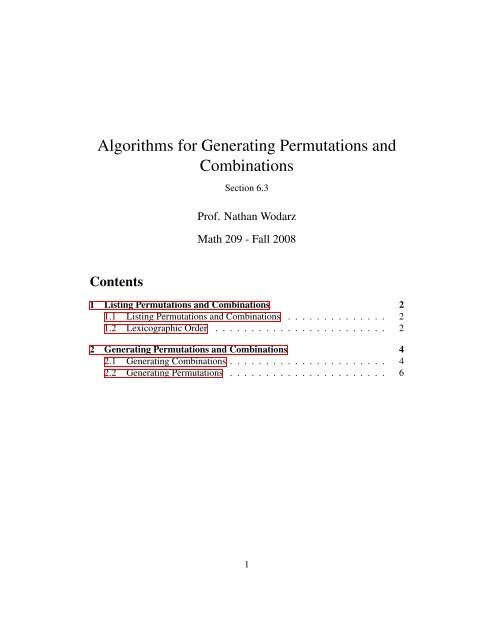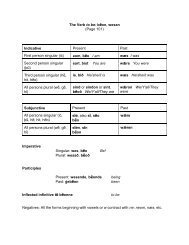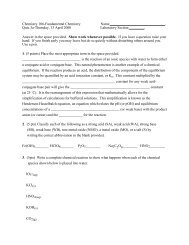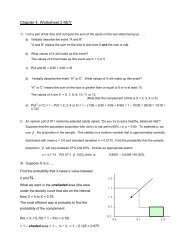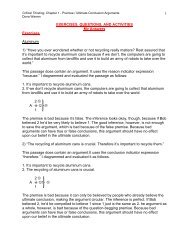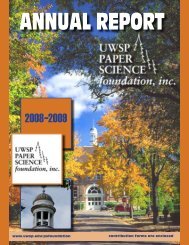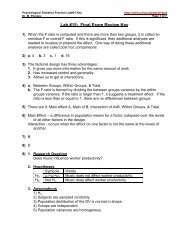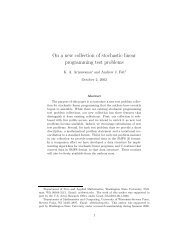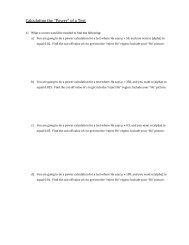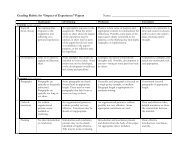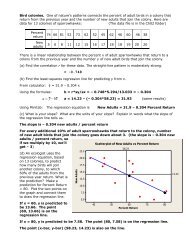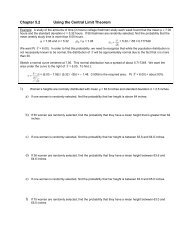Algorithms for Generating Permutations and Combinations
Algorithms for Generating Permutations and Combinations
Algorithms for Generating Permutations and Combinations
Create successful ePaper yourself
Turn your PDF publications into a flip-book with our unique Google optimized e-Paper software.
<strong>Algorithms</strong> <strong>for</strong> <strong>Generating</strong> <strong>Permutations</strong> <strong>and</strong><strong>Combinations</strong>Section 6.3Prof. Nathan WodarzMath 209 - Fall 2008Contents1 Listing <strong>Permutations</strong> <strong>and</strong> <strong>Combinations</strong> 21.1 Listing <strong>Permutations</strong> <strong>and</strong> <strong>Combinations</strong> . . . . . . . . . . . . . . 21.2 Lexicographic Order . . . . . . . . . . . . . . . . . . . . . . . . 22 <strong>Generating</strong> <strong>Permutations</strong> <strong>and</strong> <strong>Combinations</strong> 42.1 <strong>Generating</strong> <strong>Combinations</strong> . . . . . . . . . . . . . . . . . . . . . . 42.2 <strong>Generating</strong> <strong>Permutations</strong> . . . . . . . . . . . . . . . . . . . . . . 61
1 Listing <strong>Permutations</strong> <strong>and</strong> <strong>Combinations</strong>1.1 Listing <strong>Permutations</strong> <strong>and</strong> <strong>Combinations</strong>Listing <strong>Permutations</strong> <strong>and</strong> <strong>Combinations</strong>• Goal: List all permutations <strong>and</strong>/or combinations of a set• Problems:– Lots of them– How can we be sure all are listed?– Idea: Put some sort of order on permutations/combinations1.2 Lexicographic OrderLexicographic Order• Will use lexicographic order to list all permutations <strong>and</strong>/or combinations• Similar to dictionary (alphabetical) order– If Word A is shorter than Word B, <strong>and</strong> every letter of Word A occurs inthe same place in Word B, Word A comes be<strong>for</strong>e Word B (”compute”<strong>and</strong> ”computer”)– If the first letter that differs in Word A comes be<strong>for</strong>e the correspondingletter in Word B, then Word A comes be<strong>for</strong>e Word B (”math” <strong>and</strong>”matter”)• For strings α = s 1 s 2 s 3 · · · s p <strong>and</strong> β = t 1 t 2 t 3 · · · t q taken from the set {1, 2, 3, . . . , n}– For example, α = 1742 <strong>and</strong> β = 18285 are strings over {1, 2, 3, 4, 5, 6, 7, 8}– We write α < β (α is lexicographically less than β) provided that∗ p < q <strong>and</strong> s i = t i <strong>for</strong> 1 ≤ i ≤ q (e.g., α = 1732 <strong>and</strong> β = 173245)∗ For the first i such that s i t i , s i < t i (e.g., α = 28473 <strong>and</strong>β = 2848)2
Lexicographic Order <strong>and</strong> <strong>Permutations</strong>Example. For the following 4−permutations from the set {1, 2, 3, 4, 5, 6, 7}, findthe permutation that immediately follows them in lexicographic order1. 1234 is followed by2. 4567 is followed by3. 5437 is followed by4. 7654 is followed byLexicographic Order <strong>and</strong> <strong>Combinations</strong>• We will always list a given combinations the order s 1 < s 2 < · · · < s pExample. For the following 4−combinations from the set {1, 2, 3, 4, 5, 6, 7}, findthe combination that immediately follows them in lexicographic order1. 1234 is followed by2. 3467 is followed by3. 4567 is followed by3
2 <strong>Generating</strong> <strong>Permutations</strong> <strong>and</strong> <strong>Combinations</strong>2.1 <strong>Generating</strong> <strong>Combinations</strong><strong>Generating</strong> <strong>Combinations</strong>• Given a string α = s 1 · · · s r , to find the next string (as a combination)– Find the rightmost element not at its maximum value– Don’t change anything be<strong>for</strong>e that element– Increment the element found above– Each additional element is one more than the previous• For 5-combinations of {1, 2, 3, 4, 5, 6, 7, 8}:– We will find successor of 13578– What is rightmost element not at its maximum?– Increase that by 1– List remaining elements in order.– Successor is4
Algorithm <strong>for</strong> <strong>Generating</strong> <strong>Combinations</strong>List all r-combinations of {1, 2, . . . , n} in increasing lexicographic order.Input: r, nOutput: All r-combinations of {1,2,...,n}in increasing lexicographic order1. combination(r,n){2. <strong>for</strong> i = 1 to r3. s i = i// Print the first r-combination4. print(s 1 , s 2 , ..., s r )5. <strong>for</strong> i = 2 to C(n,r) {6. m = r7. max val = n8. while (s m == max val){// Find the rightmost elementnot at maximum value9. m = m - 110. max val--11. }// Increment the above rightmostelement12. s r ++// All others are the successorsof this element13. <strong>for</strong> j = m + 1 to r14. s j = s j−1 + 1// Print this new combination15. print(s 1 , s 2 , ..., s r )16. }17. }5
2.2 <strong>Generating</strong> <strong>Permutations</strong><strong>Generating</strong> <strong>Permutations</strong>• Given a string α = s 1 · · · s r , to find the next string (as a permutation)– Find the rightmost place where digits increase– Don’t change anything be<strong>for</strong>e that element– Make the left element of the pair as small as possible but still largerthan it was– Each additional element is as small as possible• For permutations of {1, 2, 3, 4, 5, 6}:– We will find successor of 135642– What is rightmost place the digits increase?– Increase the leftmost to be smallest possible– List remaining elements in smallest to largest.– Successor is6
Algorithm <strong>for</strong> <strong>Generating</strong> <strong>Permutations</strong>List all permutations of {1, 2, . . . , n} in increasing lexicographic order.Input: nOutput: All permutations of {1,2,...,n} in increasing lexicographic order1. permutation(n){2. <strong>for</strong> i = 1 to r3. s i = i// Print the first permutation4. print(s 1 , s 2 , ..., s r )5. <strong>for</strong> i = 2 to n! {6. m = n - 17. while (s m > s m+1 )// Find the last decrease8. m = m - 19. k = n10. while (s m > s k )// Find the last elementgreater than s m11. k = k - 112. swap(s m , s k )13. p = m + 114. q = n15. while (p < q) {// swap s m+1 <strong>and</strong> s n , swap s m+2<strong>and</strong> s n −1 , ...16. swap(s p , s q )17. p++18. q--19. }// Print this new permutation20. print(s 1 , s 2 , ..., s r )21. }22. }SummarySummaryYou should be able to:• Work with lexicographic ordering• Find the next combination <strong>and</strong>/or permutation of a given one7


